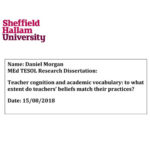Foreword: Foreign Language Learning: Complexity and Holistic Considerations
Rahma Ibrahim Al-Mahrooqi
Sultan Qaboos University Oman
Human language is a far more complex phenomenon than merely a system of sounds and symbols and rules to combine them. It is an adaptive social, affective and cognitive entity composed of inter-connected components and processes hard to unravel and understand (Beckner et al, 2009; Al-Mahrooqi & Tuzlukova, 2011; Chaika, 1994). Language neither exists in a vacuum nor is determined by a set of limiting factors. Since it reflects societal complexities, its use varies, depending on situational and user-related factors which are numerous and changing. It is clear, however, that its main aim is communication and that communicative competence is essential for it. And yet because logic and research tell us there is no such condition as perfect competence (Nunn, 2007, 2011), no individual can claim possession of it. Within conversation, problems often arise, but competent speakers using compensation strategies can usually solve them. A mastery of strategies for meaning negotiation, therefore, is a huge advantage enjoyed by effective communicators.
Learning a foreign language, let us agree, is a remarkable feat, involving such factors as personal differences, age, aptitude, motivation and attitudes, curriculum and teaching methods, teacher variables, feedback and assessment – to say nothing of a myriad other elements that determine what gets acquired and to what degree of competence. Performance, or language production, is said to be a reflection of competence, but the two are not synonymous since performance might lag behind competence in some situations and contingencies.
This June issue of the journal addresses the complexity of language learning from different perspectives. The nine articles included are diverse, yet they all acknowledge the multiple and intertwining roles of factors that either promote or hinder language learning.
Roger Nunn’s editorial piece, “An argument for Holism Part 2”, continues a previous contribution on the connection between holism and complexity, exploring holistic views’implications for such areas as language and discourse use, motivation, assessment, task-based curriculum and methodology. Taking an unequivocal stance against binary comparisons, he urges EFL theorists and practitioners to adopt a holistic perspective on education and research as this “provides a theoretically sound means of adapting to context at the same time as integrating atomistic activities or studies into a meaningful whole.” (p.20). He further suggests more research on “real-life learning conditions” in order to support ‘creative, rational practice” (p. 20).
Article two, “The effect of verbal glosses on vocabulary learning and reading comprehension”, by Vahid Salehi and Farid Naserieh, acknowledges the importance of vocabulary as a vital building block for language learning. In particular, it investigates the effect of four types of verbal glosses – namely L1, L2, bilingual, and mixed – on reading comprehension and incidental vocabulary learning and retention. Basically, glossing, it is suggested, is more helpful than non-glossing, and mixed glossing is even better still.
The article by Mohammadtaghi Shahnazari-Corcheh, Rebecca Adams, and Saeed Ketabi’s entitled “The Relationship between modified output and working memory capacity” addresses the issue of corrective feedback from a cognitive perspective, examining short-term phonological memory’s effect on modified output arising from elicitation as a form of corrective feedback. Their study’s findings suggest that “there is a positive significant correlation between PSTM and modified output following elliptical elicitation” (p. 65).
The fourth article, by Glen Poupore, is entitled “The influence of L2 motivation and L2 anxiety on adult learners’ socio-affective conditions and language production during communicative tasks”. The study it reports is premised on the rationale that it is important to take into consideration learners’ affective variables, which function with cognitive variables within the social context where language learning occurs. The findings showed that, within task-based group work, “learners with a high L2 motivation and/or international posters were more highly motivated, more emotionally comfortable and had more positive perceptions of the social group dynamic during task performance” (p. 93).
Focusing on metadiscourse resources in the opening sections of introductory and scholarly textbooks, Davud Kuhi, Marzieh and Maryam Yavari analyzed a corpus of 30 pieces, evenly divided between the two textbook types. Slight differences were found, which can be explained in terms of the textbooks’ awareness of their audiences’ needs and abilities. The authors call for more research into the role of metadiscourse in academic texts.
As indicated by its title, Jerry Gebhard’s article, “EFL learners studying abroad: Challenges and strategies”, examines the challenges faced by students from Asian EFL backgrounds who are studying in US universities. It looks at the adaptation strategies they use to overcome these challenges. The findings show learners facing diverse challenges around academic life, social interaction, and emotional reactions to their new environment. They respond by using coping, observing, imitating and reflecting strategies.
Jim Yee Him Chan’s study examines Hong Kong’s sociopolitical, socioeconomic, and sociolinguistic situation in order to evaluate the appropriateness of using English as a lingua franca (ELF) in the local EFL classroom. The author holds that, while the use of an ELF multilingual model can be advantageous, applying it might be premature before an in-depth analysis of the Asian sociolinguistic situation is carried out.
In article eight, John Trent investigates, from the perspective of teacher identity, English language instructors’ use of the L1 in L2 teaching when using English as a medium of instruction (MOI). Being both experiential and rational, identity is a penetrating concept that is not static, but rather dynamic, multifaceted, evolving and socio-politically and professionally determined (Al-Mahrooqi, 2012). Hence, it is bound to have an influence on teacher beliefs and practices. Using interviews with pre-service English language teachers in Hong Kong, Trent found that they were challenged by MOI issues as they “struggled with multiple identities at the institutional, interpersonal, and intrapersonal levels” (p. 215). He discusses the implications for teacher education and policy implementation around the use of L1 in L2 teaching in Hong Kong’s MOI classes.
On the subject of identity construction, Nancy Burkhalter’s article, “Overcoming resistance in post-Soviet teacher trainees in Kazakhstan”, explores pre-service teachers’ negative attitudes and resistance to new teaching methodologies because, as students, they were trained under a politically authoritarian regime. To circumvent this resistance, she discusses three techniques that draw on research in the areas of psychology, critical thinking and education.
Though the issue’s nine articles are distinctive in their approach, they all acknowledge the important role of a multitude of factors in foreign language learning. Variables around context, learner, and teacher work together to affect the learning process, and only through a holistic view can we think about all these factors in relation to one another. They simply do not work separately and independently.
References
Al-Mahrooqi, R. (2012). Forward: EFL/ESL teacher identity. The Asian EFL Journal Quarterly,
June Issue, 14(2), 4-8.
Al-Mahrooqi, R. & Tuzlukova, V. (2011). Negotiating meaning in the EFL context. Pertanika
Journal of Social Sciences and Humanities, 19(1), 183-198.
Beckner, C; Blythe, R; Bybee, J; Christiansen, M.H.; Croft, W; Ellis, N.C.; Holland, J; Jinyun
Ke; Larsen-Freeman, D; Schoenemann, T. (2009). Language is a complex adaptive system. Language Learning 59 Suppl. 1, December 2009, pp.1-26.
Chaika, E. (1994). Language: The social mirror (3rd Ed.). Ontario: Heinle and Heinle Publishers.
Nunn, R. (2011). From defining to developing competence in EIL and intercultural
communication. The Journal of English as an International Language. 6, (1), pp. 21-46.
Nunn, R. (2007). Re-defining communicative competence for international and local
communities. Asian EFL Journal, 9 [4], pp. 76 – 109.








